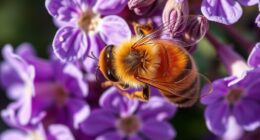Biodiversity is essential for boosting productivity in ecosystems. When you have a diverse range of species, they work together more efficiently, utilizing resources better and reducing competition. This cooperation leads to healthier plant life and more stable nutrient cycles. In fact, a 10% loss in biodiversity can shrink productivity by around 3%. The vibrant interactions among species foster resilience, allowing ecosystems to bounce back from stressors. So, if you want to understand how important biodiversity is for thriving environments, there's much more to explore about its powerful role and the strategies to enhance it.
Key Takeaways
- Biodiversity enhances ecosystem productivity by providing multiple nutrient and energy pathways, ensuring efficient resource utilization.
- Diverse plant species contribute to agricultural sustainability by offering a wider range of crops and food sources.
- High species diversity reduces competition and promotes more efficient resource use, leading to increased productivity.
- Ecosystems with greater biodiversity exhibit resilience to environmental stressors, maintaining stability and productivity over time.
- Maintaining biodiversity yields significant economic benefits, providing over five times the value compared to conservation costs.
Definition and Importance of Biodiversity

Biodiversity, the rich tapestry of life on Earth, plays an essential role in sustaining ecosystems and human societies. It encompasses the variability of life, including genetic, species, ecosystem, and phylogenetic diversity.
You'll find that biodiversity isn't evenly distributed; it flourishes in the tropics, where warm climates boost productivity. Tropical forests, covering less than one-fifth of Earth's land, harbor about 50% of all species. Additionally, the current rates of biodiversity decline match or exceed those of past mass extinction events, highlighting the urgent need for conservation efforts.
Each species, no matter how small, contributes to ecosystem balance and function. Furthermore, genetic diversity within populations enhances their long-term survival.
Relationship Between Biodiversity and Productivity

Understanding the relationship between biodiversity and productivity reveals how intertwined these concepts are in sustaining healthy ecosystems. When you increase biodiversity, you enhance productivity; studies show that a 10% loss in biodiversity can result in a 3% drop in productivity. Diverse ecosystems provide various nutrient and energy pathways, boosting stability and overall function. With more plant species, you guarantee a wider range of crops, promoting natural sustainability. Additionally, species interactions like pollination and competition contribute to these dynamics. The economic implications are significant; maintaining biodiversity offers more than five times the value compared to conservation costs. Protecting diverse ecosystems is essential not only for their health but also for our own well-being and economic stability. Furthermore, higher biodiversity levels are associated with increased ecosystem productivity, reinforcing the need for conservation efforts.
Role of Habitat Diversity

When diverse habitats coexist within an ecosystem, they considerably enhance its functioning and resilience. You'll notice that ecosystems with various habitats achieve higher levels of multifunctionality, meaning they can perform multiple ecological processes more effectively. These habitats foster positive interactions, allowing the exchange of materials and energy like oxygen and organic matter. Additionally, they boost bacterial and microalgal diversity, which directly contributes to overall ecosystem health. Seasonal variations also play a role; the impact of habitat diversity is more pronounced in summer, while it shifts in autumn. This diversity is crucial because diminished habitat diversity leads to a decrease in species diversity and ecosystem functions. Ultimately, the structural complementarity of different habitats supports ecological resilience, ensuring that ecosystems can adapt, recover, or resist disturbances while providing essential services and benefits.
Species Diversity and Ecosystem Functioning

Species diversity directly influences ecosystem functioning, as a greater variety of organisms typically leads to enhanced productivity and stability.
When you have high-diversity mixtures, you'll find they can be about twice as productive as monocultures. Different species efficiently utilize various resources, reducing competition and promoting overall resource use.
This increased diversity also enhances nutrient dynamics, boosting nutrient stores and supply rates. Furthermore, higher biodiversity decreases herbivory and disease risks, contributing to overall productivity. Additionally, ecosystems with high biodiversity exhibit greater resilience against environmental stressors, further ensuring stability.
Ecosystems rich in species are more resilient to disturbances, ensuring stability. Remember, the loss of a single species can profoundly affect the entire ecosystem, showcasing the critical importance of maintaining species diversity for a thriving environment.
Genetic Diversity and Adaptation

Maintaining a rich tapestry of species diversity not only supports ecosystem functioning but also lays the groundwork for genetic diversity, which is crucial for adaptation.
Genetic diversity provides the raw material for evolution, allowing populations to thrive amid changing environments. When you have high genetic diversity, individuals with beneficial traits stand a better chance of surviving and reproducing. This adaptability helps populations resist environmental changes, diseases, and climate shifts. Mechanisms like gene flow and mutation introduce new variations, enhancing survival further. Additionally, high genetic diversity helps increase ecosystem resilience, enabling systems to recover more effectively from disturbances.
Without genetic diversity, populations may struggle to adapt, increasing their vulnerability to extinction. Prioritizing genetic diversity conservation is essential for ensuring that ecosystems remain healthy and resilient in the face of future challenges.
Biodiversity and Ecosystem Resilience

Biodiversity plays an essential role in enhancing ecosystem resilience, as it fosters a network of complex interactions among various organisms. When species interdepend on one another, the removal of a single species can trigger significant consequences, potentially leading to ecosystem collapse.
Think of ecosystems like a house of cards; some species are crucial for stability, while others are less essential. For instance, honey bees are fundamental for pollination in agricultural systems, and their decline threatens food production. The extinction of one species can disrupt these loops, potentially leading to resource depletion for others and significant ecosystem changes.
Scientific studies, including those by the Nutrient Network, show that conserving biodiversity is key to maintaining stable ecosystems. Ultimately, a rich tapestry of life helps ecosystems adapt to changes, mitigating the impacts of climate change and promoting a healthier planet.
Strategies for Enhancing Biodiversity

Protecting ecosystem resilience naturally leads us to contemplate effective strategies for enhancing biodiversity.
Start by preserving and restoring habitats through designated protected areas and reforestation efforts. Monitor invasive species and implement management plans to safeguard native ecosystems. Additionally, it is essential to assess impacts of invasive species on local ecosystems to inform management strategies.
Prioritize native plants in landscaping projects, and create educational outreach programs to highlight their importance. Engaging your community fosters a culture of environmental awareness and encourages participation in green initiatives.
Consider installing artificial habitats to support various species and embrace permeable surfaces to enhance plant growth and groundwater replenishment.
Frequently Asked Questions
How Can Individuals Contribute to Biodiversity Conservation?
You can contribute to biodiversity conservation by supporting local farmers and choosing organic products.
Engage in Community Supported Agriculture (CSA) to enjoy fresh, seasonal produce while aiding local economies.
Plant native species in your garden to create habitats for local wildlife, and encourage pollinators by adding nectar-producing flowers.
Also, respect local habitats by sticking to paths and participating in restoration projects.
Every small action you take helps preserve the rich diversity around you.
What Are the Main Threats to Biodiversity Today?
Imagine a vibrant forest, teeming with life, suddenly silenced by pollution, habitat loss, and climate change.
Today, biodiversity faces significant threats. Climate change shifts ecosystems, while pollution contaminates air and water, harming countless species.
Habitat loss, driven by agriculture and logging, isolates populations, and invasive species wreak havoc, disrupting ecosystems.
Each of these challenges diminishes the rich tapestry of life that sustains our planet, calling for urgent action to protect what remains.
How Does Climate Change Impact Biodiversity?
Climate change greatly impacts biodiversity in various ways.
You'll notice increased extreme weather events, like storms and droughts, disrupting habitats and threatening species.
Rising global temperatures force many species to migrate or adapt, which isn't always successful.
Ocean acidification makes it harder for marine life, like corals and shellfish, to thrive.
As these changes unfold, you might witness a decline in species and ecosystems, ultimately affecting the balance of nature around you.
What Role Do Invasive Species Play in Ecosystems?
Invasive species disrupt ecosystems, outcompeting native species, spreading disease, and altering habitats.
They prey on vulnerable populations, leaving little room for recovery. As they thrive, they choke out native flora and fauna, causing cascading effects throughout the food web.
You might see familiar landscapes transform into unrecognizable environments, where the balance of nature shifts.
The impact is profound, leading to loss of biodiversity and economic strain, making it essential to manage these invaders.
How Is Biodiversity Measured Scientifically?
To measure biodiversity scientifically, you can use various techniques like sampling, surveys, and DNA sequencing. You might participate in citizen science programs, which contribute valuable data.
Indices like Simpson's and Shannon-Weaver help quantify species richness and evenness. Additionally, you can conduct assessments to understand changes in biodiversity due to human impact or natural events.
Collecting and analyzing data efficiently is essential for accurately measuring and communicating biodiversity's status.
Conclusion
To sum up, embracing biodiversity isn't just important; it's the secret sauce that turns an ordinary ecosystem into a flourishing paradise! By nurturing diverse habitats, species, and genetic variations, you're not only boosting productivity but also building resilience against environmental changes. So, let's roll up our sleeves and implement strategies that enhance biodiversity. Together, we can create ecosystems that thrive like never before, ensuring a vibrant planet for generations to come!









